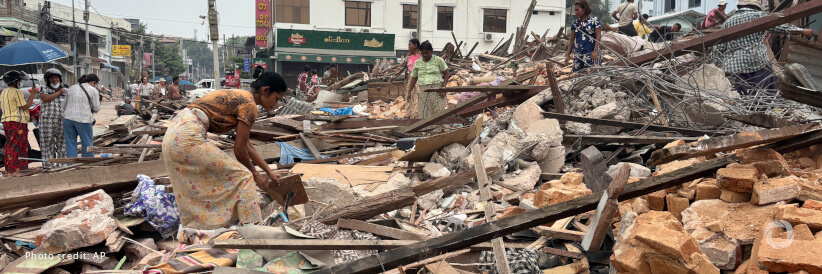On March 28, a powerful 7.7-magnitude earthquake struck central Myanmar, devastating the regions of Mandalay, Naypyidaw, Sagaing, and Shan State. In the immediate aftermath, Doctors Without Borders/Médecins Sans Frontières (MSF) reaffirmed its commitment and capacity to deliver large-scale emergency medical assistance across all impacted areas.
MSF has prioritized responding in the hardest-hit and currently accessible cities of Mandalay and Naypyidaw, while serious concerns persist for people living in more remote and less accessible areas such as Sagaing.
As of April 8, over 3,600 deaths have been reported, more than 5,000 people injured, and an estimated 17 million individuals affected—many severely. Key infrastructure sustained significant damage, including hospitals, roads, and water systems, while ongoing telecommunication disruptions continue to hamper relief efforts.
The earthquake struck a country already gripped by several health crises and conflict, compounding the challenges communities face. Limited resources, staff, and supplies have left some facilities overburdened and struggling to respond to the growing health needs.
While local communities are demonstrating remarkable solidarity, our staff have reported extensive destruction. Many residents remain outdoors for fear of aftershocks, while monasteries have opened their doors to host displaced families.
Damaged infrastructure compromises healthcare
In the hardest-hit cities, damage to infrastructure has severely impacted hospitals’ ability to function. Due to fears of further building collapse, structural damage has forced medical staff to treat patients outside in some cases.
In Naypyidaw and Mandalay, where hospital systems were particularly damaged, MSF carried out assessments, delivered medical supplies, and initiated discussions with key stakeholders, including the Ministry of Health.
In Mandalay, the teams are working to improve water, sanitation, and hygiene conditions in damaged hospitals by installing water tanks and additional handwashing basins. Teams are reinforcing waste management with dozens of bins and helping patients cope with extreme heat –often reaching 104°F –while awaiting treatment outside damaged facilities by setting up fans.
At the same time, mobile medical teams began providing consultations in makeshift shelters including monasteries, treating a range of conditions from common illnesses to chronic diseases such as diabetes and hypertension. In southern Myanmar, mobile teams also distributed essential non-food items, restored clean water sources, and continued assessments in affected and displaced communities.
The psychological impact of the earthquake
A key priority for our response is mental health. In Mandalay, teams composed of trained staff and student volunteers have been visiting patients in surgical, orthopedic, and trauma wards at local hospitals to provide psychological first aid. In a context where survivors face high levels of psychological stress, these efforts are essential. The disaster and the fear of aftershocks, which continue to be recorded, in addition to the consequences of the ongoing conflict ravaging many parts of the country, contribute to this stress.
Major concerns over the expected environmental impact
With the rainy season approaching, floods and landslides could exacerbate existing access challenges, particularly in remote areas. The rainy season also significantly heightens the likelihood of public health threats associated with outbreaks of waterborne diseases such as cholera, and vector-borne diseases like malaria or dengue fever. This is due to the potential flood-related contamination of the already reduced number of safe water sources. Immediate actions like scaled-up provision of clean water, safe sanitation facilities, distribution of mosquito nets, and hygiene promotion are essential to mitigate the additional threats.
What needs to happen
To address the immense needs, humanitarian aid must reach all affected areas, including hard-to-reach locations, unhindered. To avoid longer-term harmful consequences for people grappling with the aftermath of this earthquake, a further significant scale-up of aid and assurance of access to health care in all affected areas is urgently needed.
As part of MSF’s long-standing presence in Myanmar since its first intervention in 1992, we reaffirm our readiness to provide emergency medical humanitarian assistance wherever needed, as we continue to support communities affected by conflict, disease, and now, one of the worst earthquakes to strike the region in recent history.

